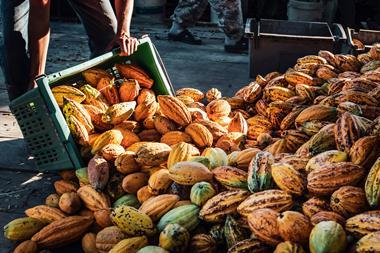Sales of spreads could be reinvigorated in many ways - convenient new packaging concepts, a more modern image, more unusual ingredients as well as more imaginative merchandising
According to manufacturers and retailers alike, despite the poor figures in the jam and marmalade categories, there is still plenty of scope to reinvigorate sales.
Kate Pratt, buyer of jams and spreads at Tesco, for example, says: “There is an opportunity to optimise the current consumer mega trends of convenience and health through the delivery of new packaging concepts in addition to new product offerings.”
According to Andros UK, which owns the Bonne Maman brand, consumers don’t see marmalade as part of their lifestyle. “It’s perceived as old-fashioned and dusty,” says a spokesman.
“If you can get young people to consume jams, then they may go on to eat more marmalade.”
This is reflected by TNS figures, which reveal that the over-45s account for 81% of marmalade compared with just 4% of under-16s.
Patrick Finlay, head of marketing at Robertson’s, says better merchandising will also help jams and honey shrug off their dusty image. “Consumers find the sweet spreads fixture confusing,” he says. Robertson’s and Frank Cooper owner RHM says it has undertaken new consumer and shopper research to help develop the category and will use this to help promote new product launches planned for early this year.
“The RHM culinary brands category vision will improve merchandising, helping the shopper decode the fixture and adding significant growth to sweet spreads,” says Finlay.
Julian Dunn, general manager for convenience and spreads at Premier Foods, which owns the Hartley’s range of jams and marmalades, also says better products and merchandising are needed. “It is important to attract new users to the fixture in order to reverse the decline.
“We have launched two new variants - lemon and thick cut - under the more youthful Hartley’s Best brand, which we hope will increase penetration and lower the age profile.”
According to Wilkin & Sons, which makes Tiptree preserves, the trend is away from thick cut towards fine peel, with the consumer becoming more interested in combinations of fruit, such as orange with tangerine, lemon or lime.
With regard to jams, Michael Simpson-Jones, buyer for hot beverages and breakfast spreads at Waitrose, says: “Premium jams continue to outperform standard jam and healthier spreads are also seeing growth.
“The impact of the Glycaemic Index system has helped flavours such as cranberry and blueberry to perform well in the market, but strawberry still remains number one.”
Ian Thurgood, joint MD at Wilkin & Sons, adds that there is a resurgence in demand for gooseberry and a fast-growing interest in quince.
Judith Sinclair-Smith, category marketing manager at The Co-operative Group, adds that its most
successful introduction last year was the range of four Robertson’s 227g jar size, which it says has grown the standard jam sector by 18% in both value and volume year-on-year, despite strong competition from own label and Hartley’s Best.
This range appeals to the society’s customers, mainly single households, she says. “Once opened, these products have a limited shelf life, six weeks if stored in a fridge, so single users have more chance of using it before it deteriorates - older customers don’t like waste.”
She also feels that the market is crying out for some above-the-line lifestyle activity that celebrates the pleasure and indulgence of sweet spreads.
“Television advertising, perhaps with poster and tasting campaigns, showing jam being spooned on to fresh bread or scones, would help,” she says.
“This would position sweet spreads as something to eat for pleasure and remove the need to pigeonhole them as products intended for breakfast or tea-time eating occasions only.”
According to RHM, Robertson’s enjoyed four months of television advertising support in 2005, which it claims is the highest level of support for any brand within a category where above-the-line support is rare.
However, packaging still remains an issue in jams. While US companies such as Smuckers have put their jams into top-down squeezy formats to be more attractive to consumers, many UK companies still stick to more traditional jam formats.
According to manufacturers and retailers alike, despite the poor figures in the jam and marmalade categories, there is still plenty of scope to reinvigorate sales.
Kate Pratt, buyer of jams and spreads at Tesco, for example, says: “There is an opportunity to optimise the current consumer mega trends of convenience and health through the delivery of new packaging concepts in addition to new product offerings.”
According to Andros UK, which owns the Bonne Maman brand, consumers don’t see marmalade as part of their lifestyle. “It’s perceived as old-fashioned and dusty,” says a spokesman.
“If you can get young people to consume jams, then they may go on to eat more marmalade.”
This is reflected by TNS figures, which reveal that the over-45s account for 81% of marmalade compared with just 4% of under-16s.
Patrick Finlay, head of marketing at Robertson’s, says better merchandising will also help jams and honey shrug off their dusty image. “Consumers find the sweet spreads fixture confusing,” he says. Robertson’s and Frank Cooper owner RHM says it has undertaken new consumer and shopper research to help develop the category and will use this to help promote new product launches planned for early this year.
“The RHM culinary brands category vision will improve merchandising, helping the shopper decode the fixture and adding significant growth to sweet spreads,” says Finlay.
Julian Dunn, general manager for convenience and spreads at Premier Foods, which owns the Hartley’s range of jams and marmalades, also says better products and merchandising are needed. “It is important to attract new users to the fixture in order to reverse the decline.
“We have launched two new variants - lemon and thick cut - under the more youthful Hartley’s Best brand, which we hope will increase penetration and lower the age profile.”
According to Wilkin & Sons, which makes Tiptree preserves, the trend is away from thick cut towards fine peel, with the consumer becoming more interested in combinations of fruit, such as orange with tangerine, lemon or lime.
With regard to jams, Michael Simpson-Jones, buyer for hot beverages and breakfast spreads at Waitrose, says: “Premium jams continue to outperform standard jam and healthier spreads are also seeing growth.
“The impact of the Glycaemic Index system has helped flavours such as cranberry and blueberry to perform well in the market, but strawberry still remains number one.”
Ian Thurgood, joint MD at Wilkin & Sons, adds that there is a resurgence in demand for gooseberry and a fast-growing interest in quince.
Judith Sinclair-Smith, category marketing manager at The Co-operative Group, adds that its most
successful introduction last year was the range of four Robertson’s 227g jar size, which it says has grown the standard jam sector by 18% in both value and volume year-on-year, despite strong competition from own label and Hartley’s Best.
This range appeals to the society’s customers, mainly single households, she says. “Once opened, these products have a limited shelf life, six weeks if stored in a fridge, so single users have more chance of using it before it deteriorates - older customers don’t like waste.”
She also feels that the market is crying out for some above-the-line lifestyle activity that celebrates the pleasure and indulgence of sweet spreads.
“Television advertising, perhaps with poster and tasting campaigns, showing jam being spooned on to fresh bread or scones, would help,” she says.
“This would position sweet spreads as something to eat for pleasure and remove the need to pigeonhole them as products intended for breakfast or tea-time eating occasions only.”
According to RHM, Robertson’s enjoyed four months of television advertising support in 2005, which it claims is the highest level of support for any brand within a category where above-the-line support is rare.
However, packaging still remains an issue in jams. While US companies such as Smuckers have put their jams into top-down squeezy formats to be more attractive to consumers, many UK companies still stick to more traditional jam formats.

















No comments yet